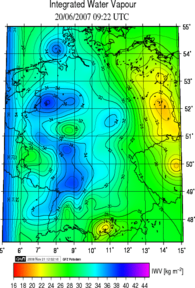The research projects COPS-GRID ("High-resolution Reanalyses and Impact Studies for Improving Process Understanding and Precipitation Forecast Skill based on the COPS Data Set") followed by APRO-GRAVAR ("Assimilation and Process Studies for selected COPS IOPs using GPS STD and radar radial velocities in the WRF-Var system") were funded within the DFG priority programme "Quantitative precipitation forecast, SPP 1167).
Within these projects the impact of GPS-derived Integrated Water Vapor (IWV) and Slant Total Delay (STD) data to improve precipitation forecasts has been investigated.
For this study GPS data from about 450 stations in Germany and France as well as from 5 GFZ stations at the Black Forrest were collected withing the framework of the international field campaign COPS (“Convective and Orographically Induced Precipitation Study”) performed in southwestern Germany/eastern France in Summer 2007. All these data were processed by GFZ and the analysis results (IWV and STDs data) were provided for the assimilation studies.
Both projects were conducted together with University Hohenheim and German Weather Service.
Publications:
- Zus, F., Wickert J., Bauer H. S., Schwitalla T., Wulfmeyer V.: Experiments of GPS slant path data assimilation with an advanced MM5 4DVAR system, Meteorologische Zeitschrift, 20, 2, 173-184, 2011.
- Behrendt, A.; Pal, S.; Aoshima, F.; Bender, M.; Blyth, A.; Corsmeier, U.; Cuesta, J.; Dick, G.; and C. Flamant, M. D.; Girolamo, P. D.; Gorgas, T.; Huang, Y.; Kalthoff, N.; Khodayar, S.; Mannstein, H.; Traeumner, K.; Wieser, A. Wulfmeyer, V. Observation of convection initiation processes with a suite of state-of-the-art research instruments during COPS IOP 8b Q. J. R. Meteorol. Soc., 2011, 137, 81-100 DOI:10.1002/qj.758
- Van Baelen J., M. Reverdy, F. Tridon, L.Labbouz, G. Dick, M. Bender, and M.Hagen On the relationship between water vapour field evolution and Precipitation systems lifecycle Q. J. R. Meteorol. Soc., 2011, 137, 204-223 DOI:10.1002/qj.785
- Wulfmeyer, V.; Behrendt, A.; Kottmeier, C.; Corsmeier, U.; Barthlott, C.; Craig, G. C.; Hagen, M.; Althausen, D.; Aoshima, F.; Arpagaus, M.; Bauer, H.-S.; Bennett, L.; Blyth, A.; Brandau, C.; Champollion, C.; Crewell, S.; Dick, G.; Di Girolamo, P.; Dorninger, M.; Dufournet, Y.; Eigenmann, R.; Engelmann, R.; Flamant, C.; Foken, T.; Gorgas, T.; Grzeschik, M.; Handwerker, J.; Hauck, C.; Höller, H.; Junkermann, W.; Kalthoff, N.; Kiemle, C.; Klink, S.; König, M.; Krauss, L.; Long, C. N.; Madonna, F.; Mobbs, S.; Neininger, B.; Pal, S.; Peters, G.; Pigeon, G.; Richard, E.; Rotach, M. W.; Russchenberg, H.; Schwitalla, T.; Smith, V.; Steinacker, R.; Trentmann, J.; Turner, D. D.; van Baelen, J.; Vogt, S.; Volkert, H.; Weckwerth, T.; Wernli, H.; Wieser, A.; Wirth, M. (2011): The Convective and Orographically-induced Precipitation Study (COPS): the scientific strategy, the field phase, and research highlights. Quarterly Journal of the Royal Meteorological Society, 137, S1, 3-30. DOI:10.1002/qj.752




